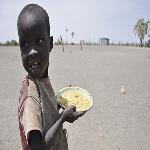Times are hard for Kenya's Turkana people. They rely on aid to survive, having suffered through prolonged drought, malnutrition and loss of livestock. But a U.S. agency is hoping to change that by providing the Turkana with grants for home grown food security projects.
Turkana is Kenya's largest district, some 77,000 square kilometers in the northwest of the country. It's semi-arid and even in the best of times has little rainfall. In recent years, it practically hasn't had any.
"The persistent drought continues from year to year, like all of last year it only rained in March. But from March all the way up to December there was no drop of rain fall. So the communities have to start moving from one location to another one, looking for pasture," said Timothy Nzioka, regional representative for the U.S. African Development Foundation or USADF.
The Turkana are pastoralists and livestock is their trade -- or was.
"Most of the animals end up dying because of lack of pasture and water," he said.
To make matters worse, Turkana is surrounded by communities in neighboring countries, who wage war through cattle raids.
Nzioka said, "The Turkana people either are messed up by the people from the north, the people from the east, the people from the south, people from the west."
Farming not an option
"Due to lack of rainfall then they have very little options to grow their own crops. So, 75 percent, according to current statistics, rely on relief," he said.
Earlier this year, the African Development Foundation launched the 5-year, $10 million Turkana Food Security Program. It's providing grants for irrigation, livestock and fisheries programs.
In the long run, said Nzioka, grants can be more effective than providing aid.
"ADF works directly with the grassroots. We do not work through other international NGOs. We don't pass our money through the government, but it goes directly to the local producers."
Preventing white elephants
He said it's important for communities to own the projects, adding, if the projects are operated simply to satisfy donor expectations they will collapse once the donors leave.
"That is why we have many white elephant projects across Africa, where donors went in and did it for the communities. As soon as the project ended nothing continued because the communities are not empowered. The communities are not in charge," he said.
The foundation designs projects to help increase local incomes and create jobs. In turn, those who benefit often contribute so others may take part.
Talking, listening
USADF talks directly to the people.
"We do not go and talk to the politicians. We do not go and talk to the provisional administration. We just don't go and talk to the chief. But we go and announce our presence and the need to talk to the community about their own challenges facing them," said Nzioka.
But talking's not enough, he said, there is a need to listen.
"These people know the problem they're faced with. They have the solution, but they lack the resources. ADF is going in to provide those resources, but must listen to them," he said.
Usually, in the end, people on all levels get involved and the community decides who'll lead the project.
This has been a record year for the U.S. African Development Foundation, which operates in 21 sub-Saharan countries. It's provided 250 new grants worth nearly $26 million. It says those grants will generate more than $60 million in additional income through 65,000 new and existing jobs.
